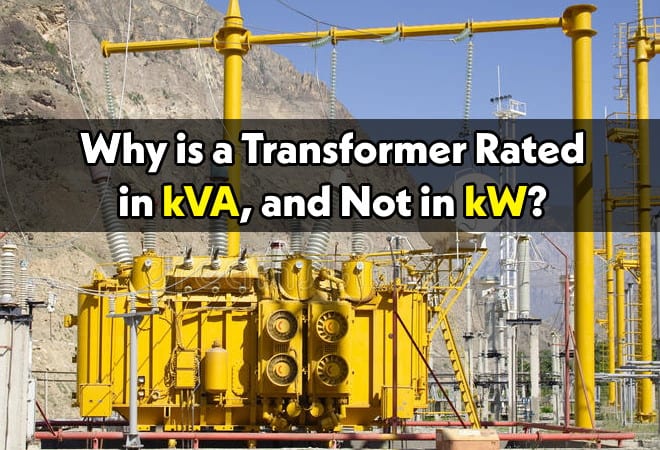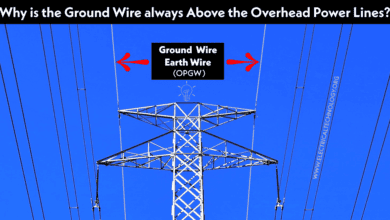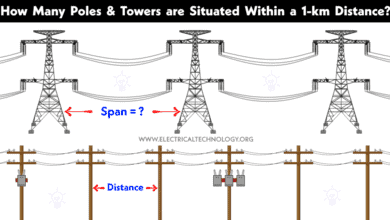Transformer are Always Rated in kVA instead of kW
As the name suggests, a transformer only transfers the power from one circuit to another without changing the value of power and frequency. In other words, It can only step up or step down the value of current and voltage while the power and frequency remain the same. A general data on the transformer nameplate is printed for further details, such as rating in VA, single phase / three phase (power or distribution transformer), step up / step down, connection etc.
Right to the question, In simple words,
There are two type of losses in a transformer;
- 1. Copper Losses
- 2. Iron Losses or Core Losses or Insulation Losses
Copper losses (I²R) depend on current which passes through transformer winding while Iron losses or core losses or Insulation losses depend on Voltage. i.e. total losses depend on voltage (V) and current (I) which are expressed in Volt ampere (VA) and not on the load power factor (P.F). That’s why the transformer rating may be expressed in VA or kVA, not in W or kW.
Let’s explain in more detail to get the idea of why a transformer is rated in VA instead of kW?
When manufacturers design a transformer, they have no idea which kind of load will be connected to the transformer e.g. they are not sure about the exact applications of transformers in different scenarios. The load may be resistive (R), inductive (L), capacitive (C) or mixed load (R, L and C). It means, there would be different power factor (P.F) at the secondary (load) side on different kinds of connected loads which additionally depends on R, L and C. This way, the rating of a transformer is expressed in Volt-Amps (VA) instead of Watts (W) in case of Transformer.
Let’s clear the rating of the transformer in VA instead of W with a solved example.
Losses of the transformer will remain the same as long as the magnitude of current / voltage is the same. No matter what power factor of the load current / voltage is.
Example:
Suppose for a single phase step up transformer
- Transformer rating in kVA = 11kVA
- Primary Voltage = 110V
- Primary Current = 100 A
- Secondary Voltage = 220V
- Secondary Current = 50 A.
- Equivalent resistance on Secondary = 5Ω
- Iron losses = 30W
In first scenario, If we connect a resistive load to the secondary of the transformer at unity power factor Φ = 1,
Then total losses of transformer would be copper losses + iron losses, i.e.:
I²R + Iron losses
Putting the values:
(502 x 5 ) + 30W = 12.53kW
i.e. losses on primary and secondary of transfer are still the same. (See below example for secondary losses as well)
The transformer output will be:
P = V x I x Cos ϕ
Again, putting the value from secondary (Same value if we put the values from primary)
P = 220 x 50 x 1 = 11kW.
Now rating of transformer:
kVA = VA ÷ 1000
kVA = (220 x 50) ÷ 1000 = 11kVA.
- Related Post: Why Earth Pin is Thicker and Longer in a 3-Pin Plug?
Now, In second scenario, connect a capacitive or inductive load to the secondary of the transformer at power factor Φ = 0.6.
Again, total losses of transformer would be copper losses + iron losses, i.e.:
I²R + Iron losses
Putting the values:
(502 x 5 ) + 30W = 12.53kW
Hence proved that losses in both primary and secondary are the same.
But the output of the transformer will be:
P = V x I x Cos Φ
Again putting the value from secondary (Same value if we put the values from primary)
P = 220 x 50 x 0.6 = 6.6kW.
Now rating of the transformer:
kVA = VA ÷ 1000
kVA = 220 x 50 ÷ (1000) = 11kVA.
It means, 11kVA transformer rating means it can handle 11kVA. It is our turn to transform and utilize the 11kVA as 11kW (we can do it by improving the power factor to 1 in case of pure resistive load) which is not predictable and even very hard to get in case of inductive and capacitive loads where the power factor would have different values.
From the above example, it is clear that the rating of the transformer is same (11kVA) but different output in power (11kW and 6.6kW) due to different power factor values after connecting different kind of loads which are not predictable for transformers manufactures where the losses are same in both cases.
So these are the exact reasons for transformer rating in kVA instead of kW.
- Related Post: What are the Tiny Cylinder in Power Cords & Cable?
Good to know:
As like a transformer, the rating and capacity of Alternators & generators, Stabilizers, UPS, Transmission lines are also rated in VA instead of W while power plant capacity, AC (Air condition) and motors are rated in W (watts) rather than VA (Volt-Amperes).
Related Posts:
- Why is a Motor rated in kW instead of kVA?
- Why is an Air-condition (AC) Rated in Ton, not kW or kVA?
- Why is an Alternator and Generator rated in kVA, not in kW?
- Why is a Battery rated in Ah (Ampere hour) and not in VA?
- Why is a Power Plant Capacity Rated in MW and not in MVA?
- Why was a Circuit Breaker Capacity Rated in MVA and Now in kA and kV?

 What is the Power Angle in a Power Transmission Line?
What is the Power Angle in a Power Transmission Line? What is Sag in Overhead Power Transmission Lines?
What is Sag in Overhead Power Transmission Lines? Why is the Ground Wire Always Positioned Above the Overhead Power Lines?
Why is the Ground Wire Always Positioned Above the Overhead Power Lines? What is the Minimum Ground Clearance for Overhead Power Line?
What is the Minimum Ground Clearance for Overhead Power Line? How Many Poles and Towers are Situated Within a 1-km Span?
How Many Poles and Towers are Situated Within a 1-km Span? Why are Overhead Power Transmission Lines Not Insulated?
Why are Overhead Power Transmission Lines Not Insulated?